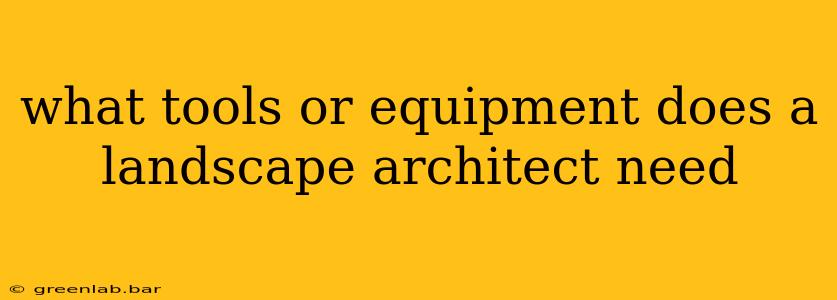Landscape architecture is a blend of art, science, and meticulous planning. Transforming barren spaces into thriving landscapes requires a diverse toolkit, encompassing both digital design software and practical field equipment. This guide explores the essential tools and equipment a landscape architect needs, categorized for clarity.
I. Digital Design & Drafting Tools: The Virtual Landscape
The initial stages of landscape design heavily rely on digital tools for creating stunning and functional plans. These are crucial for visualizing the project, presenting designs to clients, and ensuring accuracy.
Essential Software:
- AutoCAD: A cornerstone in architectural and landscape design, AutoCAD provides precision drafting and detailed plan creation. Its capabilities extend to 3D modeling, allowing for realistic visualizations.
- SketchUp: Known for its user-friendly interface, SketchUp excels in 3D modeling and rendering. It's perfect for quickly creating conceptual models and exploring various design options.
- Revit: While more complex, Revit's BIM (Building Information Modeling) capabilities are increasingly important in larger landscape projects. It allows for collaboration and detailed coordination with other disciplines.
- Landscape Design Software (specific programs): Dedicated landscape design software packages, such as Realtime Landscaping Architect or Land F/X, offer specialized tools for plant selection, grading, irrigation design, and other landscape-specific tasks. These often integrate with other design software.
- Adobe Creative Suite (Photoshop, Illustrator, InDesign): Essential for creating compelling presentations, brochures, and marketing materials. These programs allow for high-quality image editing and graphic design.
II. Field Equipment: Bringing the Vision to Life
Once the design is finalized, on-site surveying and fieldwork are crucial to ensure accurate implementation.
Surveying & Measurement Tools:
- Total Station: A sophisticated surveying instrument using lasers and electronic distance measurement (EDM) for accurate data capture. Provides precise coordinates for existing features and proposed design elements.
- GPS/GNSS Receiver: A GPS receiver aids in locating points and determining precise coordinates, especially useful for larger sites.
- Measuring Tape: A fundamental tool for measuring distances, perimeters, and areas. Steel tapes offer greater durability and accuracy compared to fabric tapes.
- Level: Essential for establishing grades and ensuring accurate elevations across the landscape. Both laser levels and traditional levels are useful depending on project scale.
- Clinometer/Inclinometer: Used to measure angles of slopes and gradients.
Other Essential Field Equipment:
- Hand Tools: Shovels, rakes, trowels, and other hand tools are necessary for smaller tasks, site analysis, and occasional on-site adjustments during construction.
- Camera & Drone (optional): High-quality photographs and aerial drone footage are invaluable for documenting existing conditions, monitoring progress, and creating compelling before-and-after presentations.
- Field Notebook & Pen: Always keep a field notebook handy for recording measurements, observations, and any necessary notes during site visits.
III. Additional Resources: Beyond the Basics
Beyond the core tools, several additional resources are crucial for success:
- Plant Identification Books & Resources: Knowledge of plant species, their growth habits, and environmental needs is fundamental.
- Construction Drawings & Specifications: Detailed construction drawings are essential for communicating design intent to contractors.
- Local Regulations & Codes: Understanding local zoning regulations, building codes, and environmental restrictions is critical for compliant designs.
This comprehensive list covers the essential tools and equipment for a landscape architect. The specific needs will vary depending on the size and complexity of the projects undertaken. However, this framework provides a solid foundation for building a successful and well-equipped landscape architecture practice.

